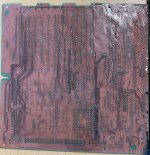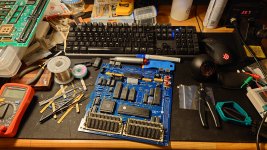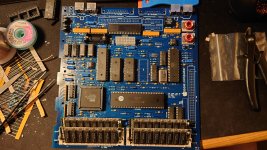-
Updated 2023-07-12: Hello, Guest! Welcome back, and be sure to check out this follow-up post about our outage a week or so ago.
You are using an out of date browser. It may not display this or other websites correctly.
You should upgrade or use an alternative browser.
You should upgrade or use an alternative browser.
Reverse Engineering the Macintosh SE PCB & Custom Chips for 1:1 reproduction
- Thread starter Kai Robinson
- Start date
quorten
Well-known member
You could tentatively count me if you're taking tentative counts. I'm still working through a different soldering project to prove to myself I'm not too much of a soldering newbie when it comes to soldering complex "computer-grade" electronics with lots of through-hole connections.
Yeah, still something I need to think about overall. Something along the lines, I would be interested if I could.
Yeah, still something I need to think about overall. Something along the lines, I would be interested if I could.
techknight
Well-known member
Im in for an SE/30 board.
When you get to that project, I have 3 or 4 dead ones of those.
When you get to that project, I have 3 or 4 dead ones of those.
Busterswt
Well-known member
@Kai Robinson I’ll be your huckleberry. I have a donor board (albeit, with no known battery damage) and an underutilized Hakko FR-300. If you’re still looking for paying volunteers, lemme know.
Kai Robinson
Well-known member
@Busterswt Well, PM if you wanna make a donation - and if you want a board for the SE, let me know there, too.
Bolle
Well-known member
Had some time to grind away at one of my spare boards:

Going all the way down to the inner layers is going to be an absolute pain in the back.
I'll need to stock up on wheels for my grinder first.
Also it looks like the additional signaling two layers are right in the middle of the boards hidden under yet another set of VCC/GND plane layers.

Going all the way down to the inner layers is going to be an absolute pain in the back.
I'll need to stock up on wheels for my grinder first.
Also it looks like the additional signaling two layers are right in the middle of the boards hidden under yet another set of VCC/GND plane layers.
Last edited by a moderator:
LaPorta
Well-known member
Bolle, seeing your photos truly makes one see just how much damage battery acid causes, and just how damn near impossible it would be to repair such damage externally. Alternatively, however, if you guys scan this stuff in at each layer and make a diagram of what goes where, then the poor soul looking for the other end of a rotted trace actually will have a shot of bypassing it if he knows where the heck the other end is.
quorten
Well-known member
Looking pretty good, with a few more photos someone would be able to run and do another PCB layout for the Macintosh SE/30 main logic board! No need to wait around for the Macintosh SE boards to be finished. Mentioning that, it would also be really helpful for making improvements to the redrawn Macintosh SE/30 schematics. I noted elsewhere in this forum I started making improvements to fix some of the errors pointed out in the previous versions.
techknight
Well-known member
Yea, I know. You almost need a milling machine. Like what they use for doing engine heads. If you know the layer depths, you could program the machine and setup a routing bit and vacuum nozzle head and let it rip.Had some time to grind away at one of my spare boards:

Going all the way down to the inner layers is going to be an absolute pain in the back.
I'll need to stock up on wheels for my grinder first.
Also it looks like the additional signaling two layers are right in the middle of the boards hidden under yet another set of VCC/GND plane layers.
Last edited by a moderator:
Bolle
Well-known member
Getting the board stuck down evenly would be a challenge though.
I do have a DIY-hack CNC mill and in theory the step size should be accurate enough to take off a layer. I guess it’s worth a try. I have enough dead boards here to play around.
In the end careful grinding might be the best option though I think.
I do have a DIY-hack CNC mill and in theory the step size should be accurate enough to take off a layer. I guess it’s worth a try. I have enough dead boards here to play around.
In the end careful grinding might be the best option though I think.
wanderingjew
Well-known member
If you want to get a look at the inside layers of a PCB, you *can* use a small CNC mill with a small step size. This is probably the best example of that:
https://www.youtube.com/watch?v=iV4LJX1HdPk
However, there's a significant drawback going the CNC route if you don't have it perfectly flat. Half of the board will have the traces you're interested in, while the other half will cut too deep or too shallow. There's a lot of fixturing needed for this project.
I have heard of people going to a machine shop and using a surface grinder which would be a very good option if you could bond the PCB to a flat piece of steel (for the magnetic clamping). Alternatively, you could also find a machine shop with a _huge_ lapping machine. That would give you the ability to cut perfectly perpendicular through the plane of the PCB.
https://www.youtube.com/watch?v=iV4LJX1HdPk
However, there's a significant drawback going the CNC route if you don't have it perfectly flat. Half of the board will have the traces you're interested in, while the other half will cut too deep or too shallow. There's a lot of fixturing needed for this project.
I have heard of people going to a machine shop and using a surface grinder which would be a very good option if you could bond the PCB to a flat piece of steel (for the magnetic clamping). Alternatively, you could also find a machine shop with a _huge_ lapping machine. That would give you the ability to cut perfectly perpendicular through the plane of the PCB.
Kai Robinson
Well-known member
SE/30 stuff, i'll break out into a separate thread, so we can concentrate on the SE/00 board here - sorry if i've been quiet, been enjoying a few days 'staycation', visiting friends etc. I'm back home tomorrow - so will get PCB's shipped out on Monday.
Bolle
Well-known member
Kai Robinson
Well-known member
I am back from a week long staycation, and I have to say the new boards look even more amazing than the first batch did! So far the rear i/o power seems good and the GND and +5v for the 68000 and 74ACT257's is now there, along with the correct GND and +5v for the floppy and scsi, now... Just need to build one this week - they look amazing with new SIMM sockets, too!
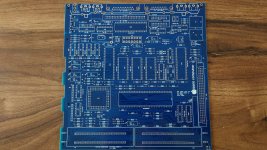

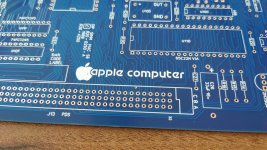

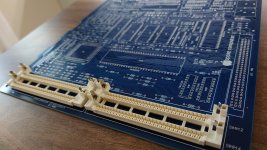





techknight
Well-known member
Yea, I know, right?Gorgeous. You have no idea how relieved I am to see the metal clips on the RAM sockets!
Kai Robinson
Well-known member
Similar threads
- Replies
- 9
- Views
- 312
- Replies
- 39
- Views
- 5K
- Replies
- 23
- Views
- 2K

